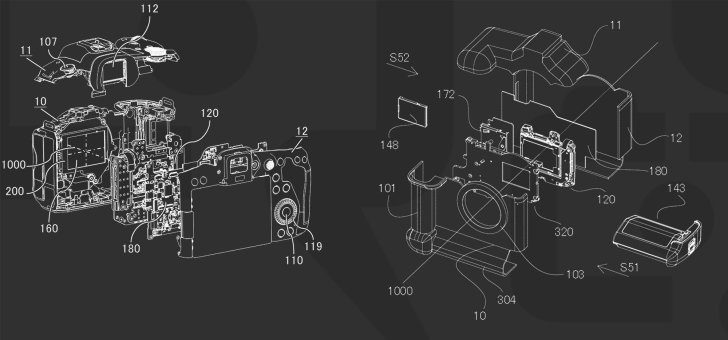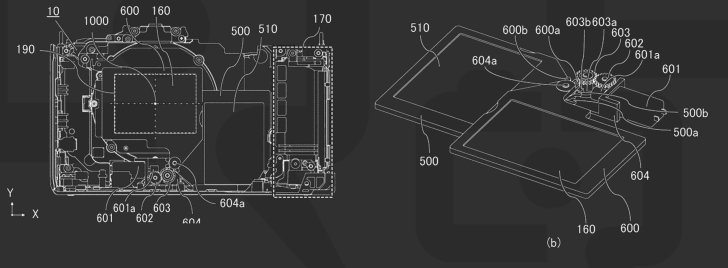One of the main complaints about using ultra-fast lenses is that you can't use the lenses easily wide open in bright sunlight. This is especially true when it comes to video and the use of more limited shutter speeds.
In this series of patent applications, Canon is discussing adding a mechanically actuated ND (Neutral Density) filter internally to the camera. The overriding concerns from all is maintaining a small form factor for the camera body, and also to prevent dust and debris from attaching to the sensor and/or the ND filter itself.
Patent Application 2023-129247 and Patent Application 2023-128193
These seem to be the core patent applications describing the built-in ND filter arrangement as it goes into the most detail with respect to the mechanical operation of the ND filter. The detail describes the ND filter controlled by a motor that allows it to swing out of the way of the sensor assembly and to be stored in a rest position between the mount and the grip area.
There is also a linear motor-driven ND filter for larger 1-series camera bodies. The 1 series camera body version has the ND filter on a set of rails that move the ND filter in and out of the optical path.

Patent Application 2023-128221
This patent application deals with the ND filter and the dust or protection shield in front of the camera's sensor, having multiple ND filters and not increasing the size of the camera. As shown in Figure 6, Canon also demonstrates having more the one ND filter installed in the camera.

Patent Application 2023-128236
This patent application discusses dust removal from the image sensor when an ND filter assembly is installed.
Patent Application 2023-128253
This patent application discusses a method of ensuring that dust does not get on the ND filter when a user is switching lenses. The ND filter sits behind the focal plane shutter which remains closed as the user switches lenses.
All in all, this is an extremely comprehensive set of patent applications detailing this additional functionality. I find it difficult to believe that Canon would spend a considerable amount of time and effort on the designs down to the mechanical details of implementation if they are not serious about bringing this to a camera system.
As with all patent applications, this may never end up as an actual patent, or even in an actual camera, but it's a comprehensive series of patents showing something that Canon is working on.
Source: Japan Patent Application 2023-128253, 2023-128236, 2023-128221, 2023-129247, 2023-128193


For stills, with my 1D X I used to use a 3-stop ND with f/1.2-1.4 primes for outdoor portraits. I no longer need it, since the 1/64000 s of the R3 gives me the same 3-stops over the 1/8000 s max of the 1D X.
If I had to make a bet, I would set my money on that there already is/will be a prototype of this in the field.
Question is, how well and reliable this will work in the field.
Not reading through all that stuff, my biggest concern would be dust on the inner side of the ND.
Sensor surface and outer ND surface are as easy to clean as we know from sensors today.
I'm not sure how well their ideas would work here,
That said, I think it is far from production, as it does not say compatible with IBIS and/or mechanical shutter.
Maybe in an R5C Mark II if they remove those things from it.
At this stage I just also hope that Canon implements CF Express 4.0 Type B for the R1 to take advantage of the faster write speeds.
When I just saw one the patents I thought there would just be a single ND filter.
Canon already does this in cameras like the PowerShot V10.
Multiple ND and sticking with fixed ND instead of VND would be quite impressive.
Canon has effective dust mitigation for sensors on all but their cheapest models.
I would assume it would not be part of a patent application f this were not effective as well.
Canon has patents discussed on this very forum 3-4 years ago to do ND fully electronically, with a sensor that would also allow a variety of other interesting abilities as well (e.g., doubling dynamic range, global shutter).
With a fast prime wide open taking sunlit portraits, I needed a 3-stop ND so that I could shoot at 1/1000 to 1/8000 s depending on actual lighting conditions. To get down to 1/250 s means an extra 3-5 stops blocked, i.e., an ND in the 6-8 stop range. Not sure that’s likely for a built-in option.
I just shot a nice series of portraits this afternoon in full sunlight, at the max x-sync shutter, with a 3 stop ND, had to close just a third of a stop from f1.4 to f1.6 to get the perfect exposure.
R6, 85 Art, 1/250s, 100iso, f1.6, ND8
Strobe was an AD200 at 1/16 power, with a 110cm umbrella with diffusion